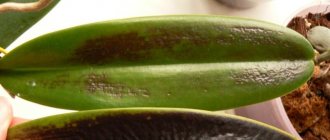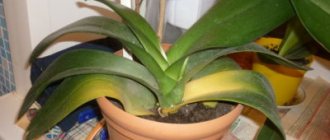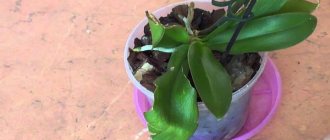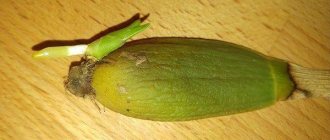Author: Elena N. https://floristics.info/ru/index.php?option=com_contact&view=contact&id=19 Category: Houseplants Published: June 26, 2012Republished: February 25, 2019Last edits: March 19, 2021
I was prompted to think about this topic by a discussion on one of the forums on the question of how to distinguish dead orchid roots from living ones. Many amateur gardeners claim that dead orchid roots have a different shade of color from living ones! Like, living roots are always light, and dead ones are dark! From my own experience I will say that you should not rely on such a principle, since there are many plants whose roots are naturally dark and brown in color.
If the color of the orchid roots has turned white, green or brown: why is this happening and what to do?
The root system of an orchid is significantly different from other indoor plants.
After all, part of the roots is underground, and the rest is on top of the soil in the pot. Accordingly, many questions arise about this.
It is important to understand what they look like in their natural state and how to recognize a diseased root.
Home care
The main factor in a healthy orchid is the condition of the rhizome system. The roots are constantly in a state of growth, and it is necessary to carefully monitor the appearance of new green roots. If this does not happen, it is worth changing the care of the flower.
Proper care of the root system consists of the following procedures:
- periodic inspection of the entire root system;
- pruning diseased areas of roots;
- transplantation (if necessary): if the root system is completely diseased, the orchid needs to be transplanted into sphagnum - an insulating layer of peat moss, and under it put a small layer of expanded clay - a porous fabric made of baked clay;
- watering the orchid as needed, i.e. when the bottom is completely dry;
- keeping the tray of the flower pot dry.
Important! It is best to keep the orchid in a plastic pot with a lattice bottom - this way the entire root system will be visible.
Pruning rules
Healthy aerial roots of silver or greenish color do not interfere with the plant and do not need to be removed. In good condition, the above-ground root system is resilient and flexible, feeling like a sponge due to the presence of hollow cells. In what cases should the procedure be performed?
It is necessary to trim if:
- mold appeared on the rhizomes;
- the roots have dried up;
- they turned black and acquired a brown tint;
- the roots are soft and slippery to the touch.
To carry out this procedure you should:
- Choose the right time: the orchid should already have bloomed.
- Use disinfected, sharp scissors.
- Find sore spots. When healthy ones are removed, there is a chance that the flower will develop a disease.
- Remove the orchid from the pot.
- Cut off the brown areas. If the damage is noticeable at the base, it is necessary to cut off the root completely.
- Treat the cuts with potassium permanganate: immerse the roots in the solution for 15 minutes.
- Soak the affected areas with vitamins: add 1 ampoule of B12, B1 to 1 liter of water and dip flower sections into it.
- Place the orchid in the soil.
What should the normal color of a healthy root system be?
The root is a vegetative organ that is responsible for vital processes. With the help of roots, the epiphytic orchid is attached to the substrate, thereby maintaining a vertical position.
A change in shades of underground or aerial roots is a signal that you need to pay attention to the flower. The normal color of healthy roots is light green or pale gray . When moistened with water, the color acquires a rich, dark shade. Not a normal color - dark brown, pale yellow with a white coating (learn more about white plaque and its treatment in this material).
In normal condition, the color of the velamen is bright white. Therefore, it is assumed that the color scheme of the root system can range from green to silver.
However,
the color of orchid roots may differ depending on :
- varieties;
- the substrate in which they grow;
- use of mineral fertilizers;
- lighting.
It should be noted that determining the condition of the roots solely by color is wrong. It is important to examine their physical condition. Healthy roots are elastic, smooth, dense . If, when pressed, a fingerprint remains on the root sprout, it means it is rotten or rotten.
By the color of the root system you can determine what disease the plant is susceptible to.
We offer you to watch a visual video about the color of the roots:
Read about what the color of orchid roots means here.
Are brown spots on the roots a cause for concern?
Lesions of any kind are a reason to examine the orchid to find out the cause . This could be pests, rot, burns, or improper care.
Brown spots on the roots clearly indicate that the plant has problems . There can be many reasons why this happens, including rotting. In the article below you will also learn what to do to help the plant in this situation.
Step-by-step instructions: what to do if the color has changed?
To green
The outer shell of the root, velamen, turns green when moistened, and when it dries it takes on a silver-gray tint. The green color of the root system indicates the health of the orchid . It is easy to determine the stage of growth by the color of the roots - young roots have a light green color, while the old root system has a more faded, inexpressive shade.
To white
This color change is associated with the use of tap, untreated water for irrigation. Hard water contains a large percentage of salts , which tend to accumulate in the soil, thereby changing its composition and blocking the flow of air to the roots. As a result, you can see a white coating on the surface of the substrate and rhizome.
carefully remove the flower from the pot and remove the remaining soil;- rinse the roots under running warm water;
- trim damaged areas of roots;
- transplant into an orchid in a new substrate;
- use exclusively purified, soft water for irrigation;
- update the soil every three years, at least.
Experienced gardeners advise collecting melt or rainwater and using it to moisten the plant.
To brown
It is important to regularly inspect the root system of epiphytes . If the flower is planted in a transparent pot, this is easy to do. It is more difficult if the orchid grows in a ceramic or clay pot, with limited access to light. In this case, the color of the roots may change.
Let's look at what's wrong if the roots of your home orchid turn brown. A similar color on the root shoots may appear due to deep planting in the substrate. Roots, with a lack of natural light, cannot fully participate in the process of photosynthesis, and as a result, chlorophyll, which is responsible for the green color, is not produced.
- take the flower out of the old pot;
- immerse the lower part of the plant in a container with warm water, leave for 2 hours;
- carefully wipe the roots with a paper towel;
- if there are damaged areas, remove them;
- transplants the orchid into a plastic transparent pot;
- place it in a well-lit place.
Possible causes of blackening of roots
It is not difficult to determine the rotting of the roots: when compressed, water oozes out of them, the top layer is easily separated, revealing the thread-like middle. The occurrence of this condition of the roots can be due to a number of reasons.
Failure to follow plant care rules
For beginning orchid lovers, one of the reasons for root rot is mistakes made in caring for orchids.
Improper watering
- Excess moisture in the pot, or, more simply, overwatering. If there is too much moisture, air access to the roots is cut off. The process of photosynthesis stops, water remains in the velamen and does not enter the leaves. The substrate creates a favorable environment for the development of pathogens. The root system begins to rot.
- Stagnation of water in the leaf axils after sprinkling. If moisture evaporates quickly from the surface of the leaf plate, then it remains in the recesses of the sinuses for a long time. Over time, a putrefactive process develops in this place. In this case, the stem of the plant and along with it the nearby roots begin to rot first. It is almost impossible to save such a plant.
- Therefore, remove any remaining water from the leaf axils. Watering with very cold or chlorinated water will also result in root rot.
It is enough to follow simple watering rules and you can avoid the loss of a wonderful tropical specimen.
Temperature
Low room temperatures and very cold window sills can also lead to slow evaporation of moisture from the substrate. This, in turn, is stagnation of cold water in the roots. In such a situation, the onset of putrefactive processes is also inevitable.
During the cold season, it is necessary to remove orchids from windows. 20 minutes in a draft, and the orchid can lose all its leaves.
Insufficient lighting
Another good reason affecting the appearance of brown spots on the roots.
The force that draws water through the velamen cells higher to the leaves appears only under certain lighting conditions. If the lighting is insufficient, then the water remains in the roots. Over time, it becomes a source of decomposition of the cellular structure of tissues.
With sufficient lighting, the water constantly moves upward, thereby feeding the orchid, which thanks to this grows intensively.
What to do if the plant has withered, but the root system is still green?
There can be a large number of factors when the leaves have dried out and the roots are still green, ranging from banal hypothermia to serious fungal diseases. Read about what to do if mold appears in a pot with an orchid here.
- Cold air entering the plant.
Of course, hypothermia provokes the shedding of buds and loss of turgor by the leaves, but the root system will remain intact. Unfortunately, affected flowers and leaves cannot be treated. Lifeless foliage must be removed, and then the pot with the plant must be moved to a warmer room and watered. In the future, avoid drafts. With proper care, after a while, young shoots will appear. Excess moisture .
Excessive moisture causes rot. A damaged orchid gradually loses its foliage, but the roots may remain partially healthy. The leaves become soft and flabby. In such a situation, you should:
- remove the orchid from the pot;
- clean the root system of soil residues and rinse with warm water;
- remove sore spots, treat sections with crushed activated carbon;
- leave the flower to dry overnight;
- transplant the exotic into a new substrate, with the obligatory presence of a drainage layer;
- control the irrigation system.
With fusarium wilt , the fungal infection spreads quite quickly, damaging the leaves.
They begin to turn yellow and fall off. If the stage of damage is not advanced, then the root system may still be healthy. Therefore, it is important to take urgent measures:- quarantine the flower;
create favorable conditions for growth;
- treat the remaining upper part of the orchid and the surface of the soil with a fungicide solution.
If the cause of the disease cannot be determined, it is better to transfer the plant with healthy roots to a greenhouse. Maintain a temperature there of +25ºС, humidity 60-70%. Be sure to provide intense lighting and regular watering with soft water. Regrowth of foliage is not a quick process, so you should be patient .
To forget about problems with roots, you should follow three recommendations: maintain the correct watering schedule, maintain a comfortable temperature and humidity, and provide the plant with a bright place. The rules are simple, but if you follow them, they will bring a lot of benefits.
Prevention
To avoid drying out of the underground part of the flower, it is necessary to create suitable conditions for the orchid.
- Watering. It is recommended to water your orchid about once a week. It is very easy to understand when a flower needs watering. You can carefully look at the walls of the container in which it grows. If condensation has formed on them, then it is too early to water. You can also determine by touch whether the flower needs watering. Before watering, the soil must dry out.
- Humidity and temperature. Orchids are very sensitive to temperature conditions, therefore, they proceed from the natural conditions of the flower’s existence. Most often, night temperatures do not fall below 18 degrees, and daytime temperatures do not rise above 28. Air circulation and humidity must also be appropriate. Very dry air in winter harms the roots, so a tray with water is placed next to the pet.
- The container is selected based on the possible size of the species. The roots of the Phalaenopsis orchid dry out when the pot is too small and rot when it is too large.
Important! If the orchid's roots have dried out, then it is too late to change the conditions. First you need to carry out sanitation.
Various diseases of orchid roots and their treatment
Orchids get sick because basic care rules are not followed:
Next, we will look in detail at what orchids suffer from and how to treat them.
White plaque
The roots of the plant may acquire a white coating if hard water with various salt impurities was used during irrigation. They gradually settle on the bicycle and tightly block the access of oxygen.
Actions on
how to cure a root covered with such plaque:
- remove the plant from the bark and rinse them well;
- if there are bad roots, cut them off with pruning shears;
- change the bark.
Subsequent watering should be done with soft filtered water and do not overdo it with fertilizing.
Read more about why orchid roots turn white here.
Yellowed
The yellowness varies - if the roots are elastic and without damage with a growing end, then it is obvious that they grew inside the bark and did not have enough light . But if, with a yellow tint, they are empty and easily lose their velomen, then they are already dead, having dried out without moisture or after damage.
We don’t touch the healthy ones, but what has dried out is cut off when transplanting the plant into a new container.
Read more about the causes of yellowing roots in this article.
Blackened
Blackness on the root system is a fairly common phenomenon. If you press on such a root and you hear a crunch, then it is clear that it is dead.
- too old orchid;
- fungal or bacterial disease;
- waterlogging and, as a result, rot;
- poor lighting due to scattered sunlight.
To help the plant, it needs to create the necessary conditions for good growth.
You can find more information on how to help an orchid with blackening roots here.
Became brown
The brown tint appears where they are deep under the bark layer.
The lack of light gives them a brown tint, but they are absolutely healthy. There is no green tint because there is no photosynthesis process.
To ensure that the roots are of a normal shade, the flower is transplanted into a container with transparent walls.
Read more about why roots turn brown in this article.
Green roots - is this normal?
Green roots are a natural process . At the moment when the plant is saturated with moisture, immediately after watering they have a bright green color. Some time later they will turn light gray, this will indicate that the flower needs regular watering.
Mold
Mold appears when there is constant high humidity and high temperatures . This will be an ideal breeding ground for mold. To prevent it from appearing, you must follow the correct watering regime , allowing the roots to be saturated with oxygen, which enters through the layers of bark.
If mold has already appeared on the roots, what should you do? The plant is removed from the soil and washed in a weak solution of potassium manganese . This will help remove mold. If severely damaged roots are noticed, they will have to be removed.
What are non-infectious diseases of orchids?
Often, diseases of indoor orchids do not occur due to infection, but as a result of improper agricultural practices. They may suffer from a lack or excess of illumination, sunburn, incorrect spectral composition of light, low air humidity, imbalance of temperature conditions, unbalanced nutrition, use of pesticides, etc. All these cultivation errors can cause the appearance of various spots on the leaves, drying out of shoots, and death roots, refusal to bloom.
See what non-infectious diseases of orchids look like in these photos:
Often, orchid growers are faced with the sudden appearance of depressed white and black spots on the leaves of phalaenopsis, which are considered a manifestation of a viral infection. In fact, the root cause of the appearance of such spots is a decrease in air temperature to 4-6 ° C (short one-time or repeated repeatedly over several nights in a row) or spraying the leaves with cold water.
Very light leaves indicate chlorosis, which is observed in epiphytic orchids in the case of a lack of iron, which is absorbed only in an acidic environment and becomes unavailable to the plant if watered with hard water, when using carbonate substrates, as well as when there is an excess of phosphorus in fertilizers.
When treating this disease of domestic orchids, the manifestation of chlorosis can be eliminated by adding iron chelate to a slightly acidified solution of macrofertilizers and periodically feeding plants with microelements.
Colorless, weeping spots may appear on the leaves of frozen orchids that were briefly kept at temperatures below 0 °C. If frostbite has not affected the tissues of the stem (in monopodially growing orchids) or rhizome (in sympodially growing orchids), areas with weeping spots should be removed immediately.
The other extreme of extreme temperature exposure is sunburn. Spots from instant burns remain on the leaves until they naturally die; unlike spots caused by pathogens, they do not increase in size.
But sometimes deformation of tissues is caused not by the sun’s rays, but by constant high temperature, when a closed greenhouse is left on a sunny window. Direct sun may not hit the leaves of the plants in it, but when the temperature in the greenhouse rises to 30 ° C or higher, the plants begin to react by taking water from the tissues of leaves, flowers, pseudobulbs, and roots. Such thermal burns appear gradually, and their consequences are much more dangerous.
In addition to sun and heat burns, chemical burns caused by too concentrated subcortex or fungicides can also be noted.
The tender tips of young growing roots are most susceptible to chemical burns.
When the temperature drops at night, young leaves of monopodially growing orchids may suffer from water accumulated inside the leaf rosette. To avoid rotting of the apical meristem and not to provoke a fungal or bacterial infection, water after watering must be removed by blotting with a napkin. If the top of the shoot is still rotten, it should be treated with a fungicide, and then be patient and wait for the lateral buds of the shoot to awaken.
The appearance of deformations and spots on developing peduncles, pseudobulbs, leaves and roots can be explained by many other reasons, from drafts to banal gnawing by cats or cockroaches.
The healing power of water
Soak the diseased orchid in water daily. Place a vessel with water and an orchid on the window. The optimal air temperature for the procedure is 20 degrees Celsius. Every morning, pour water into this vessel so that it covers only the orchid's rhizome. The orchid should “take baths” for one to two hours. If you leave it for longer, it’s also not a big deal.
To awaken dormant buds on your orchid, try bathing it in liquids that stimulate growth. An aqueous solution of Epin is suitable for this at the rate of one drop of the drug per liter of water. Don't overdo it with these baths! You should bathe in stimulants no more than once every two weeks.
How quickly does your orchid revive? It depends on your luck. For some, the orchid comes to life in a month, for others in a year. If the period of resuscitation occurs in spring-autumn days, then your chances of reviving the plant automatically double.
To prevent the roots from rotting and drying out Video - how to properly water an orchid
How to prevent an orchid from drying out?
The orchid is an unpretentious plant and can survive drought under natural conditions. When growing indoors, special rules must be followed:
- Water only as needed, i.e. only if there is completely no water at the bottom and the substrate does not look wet.
- When watering, use only settled, filtered or boiled water.
- Dry the substrate periodically, stopping water procedures for several days. The soil should be changed every 2-3 years.
- The room temperature should be 20-25 °C, and humidity – 45-70%.
- Check for fungal and viral infections and carry out treatment (if necessary).
Orchid is a special crop that requires not only close attention, but also compliance with the rules of care.
5/5 — (1 vote)
Waiting: new roots
What to do if all your efforts were not in vain and new living roots appeared on the orchids? As soon as you notice new roots, stop feeding, but continue watering for another hour. Usually, if new roots have already appeared, they will gain strength and grow literally by leaps and bounds. As soon as the young roots reach a length of 5 centimeters, you can safely plant the orchid in a pot. Do not overwater the plant; the substrate should have time to dry between waterings.
What substrate should I take? I recommend conifer bark, pure sphagnum, possibly with the addition of crushed charcoal.
The orchid must be secured in the new pot so that the roots do not break. Simply stick sticks into the substrate and tie the plant to them.
Another method of orchid resuscitation is greenhouse. You can buy a ready-made greenhouse, or you can make it yourself from an aquarium and plastic bottles.
Source
It is generally accepted that orchids are very demanding plants; caring for them is quite difficult. Despite this, many ordinary amateur flower growers cope well with capricious flowers at home. Even if you come across a fading specimen, you can fight it. Is it possible to save an orchid? Yes, that's what we'll do now.
Why do the roots of the phalaenopsis orchid turn black?
» Other »
Loading…
Question for experts: brown spots have appeared on the roots of the phalaenopsis orchid. What to do?
Sincerely, Ksenia Nekipelova
Best answers
Inna Samoilova (Voronkova):
on aerial roots this is the norm, because they dry faster
Stop flooding it, let it dry a little and normalize less frequent watering. The next time you water, add phytosporin to the water. If the roots begin to rot badly, pull them out and cut them back to living tissue. Treat the sections with crushed wood or activated carbon.
First, check for root rot - if the root at the site of this spot is not hard but softened, perhaps this is exactly the case, but it is also possible that it is damaged by pests, isolate the plant from others, if there are rotten roots, cut it to living tissue and treat the cut areas with cinnamon powder or crushed coal. Treat the roots with a fungicide, slightly reducing the recommended dose (if the roots were cut due to rot, after cutting the roots and before treatment, you need to wait about half an hour or an hour, drying the roots a little in the fresh air.) After treating with a fungicide, plant in new bark (substrate for orchids ) .(If you don’t have a new one, you can thoroughly boil the old one and dry it) But don’t worry about the orchid, it can easily remain without a substrate for a long time, since it only serves to maintain the vertical position of the plant, it is only necessary to maintain humidity.
I also recommend not to water the orchid or feed it for a week after replanting.
-answer
This video will help you figure it out
Answers from experts
There is nothing scary about this. Roots on the surface are always more susceptible to external conditions. This can be mechanical injuries and drying out, salt deposits when watering with hard water, or ingress of fertilizer. Even if they dry out, they will not rot on top (and this is much worse). Mist them occasionally between waterings. Try to water with soft water.
1. Watering “on time” for a phalaenopsis orchid is when the roots inside the pot become silver and not green, there are no droplets of moisture in the pot (condensation) and another 3-5 days will pass after that. Do not water orchids on a schedule of once every 7-10 days. This is not true. It is necessary to water only after the substrate has COMPLETELY dried.
From my own experience, I can say that even those orchids that stand side by side on the same windowsill, under the same lighting, humidity and air temperature, dry out after a different number of days, since the substrate itself (for phalaenopsis this is pine bark) is more moisture-intensive (old bark ) and less moisture-intensive (fresh bark).
2. What kind of water do you use? Even if when watering by immersion you, as expected, use settled, boiled water, when “showering” water is poured onto the orchid directly from the tap.
This means that the impurities that it contains (salts, chlorine) fall on the top layer of orchid roots - velamen, and since it has a spongy structure, it retains these harmful impurities contained in the water. This causes the roots to darken, quickly age and die.
My advice is to water by immersion using boiled water, and you can simply wipe off the dust from the leaves. The roots can also get sunburned if, immediately after watering, you place the pot with the plant on a windowsill with direct sunlight (even in winter).
3. Due to lack of light and excessive watering, the roots of the orchid may rot. Since orchids “drink” only with sufficient lighting (bright light without direct sunlight). Constant exposure to moisture is detrimental to the roots of orchids and, as a consequence, to the orchid itself.
“Remove the orchid from the pot and carefully examine the roots; If signs of rot are detected, cut off the rotten roots and sprinkle the cut areas with charcoal powder.
Transplant the plant into a smaller pot with a new slightly damp orchid substrate and place the pot in a transparent plastic bag, inflating the bag with air (do not water the soil, lightly sprinkle the sides of the bag with water).
If the roots appear fine, place the orchid back in the pot and place it in a plastic bag.
Buy a foundation and pour the substrate with its solution (2 g per liter of water), then place the pot again in a plastic bag until new leaves begin to grow and ventilate it often. After the substrate has dried, resume normal moderate watering (let the soil dry before the next watering).
“7 deadly sins” in growing orchids:
- Too much feeding. During the dormant period, plants are not fed. Doses of fertilizer cannot be exceeded. — A nearby heat source. Do not place the plant next to a radiator. — Wet leaves.
It is better to water and spray in the first half of the day. - Excessive watering. Water according to recommendations. - Cold drafts. Do not confuse ventilation and draft. - Dry air.
High air humidity and ventilation are needed.
- Bright sun. Do not keep plants in direct midday sun, shade them.
see Caring for Phalaenopsis orchids
Orchid transplantation
»
and you transplanted it into another soil, because in the store, in order to sell them, they feed them with horse doses of fertilizer, sometimes the plants get into normal conditions and die from overfeeding. It’s better to plant it in garden soil if possible, and not in purchased soil, where they always have too much fertilizer.
As a rule, plants bloom in greenhouses, but in the store they are mercilessly flooded. You need to dry the plant - this is the first thing. I would immediately replant it in a new substrate - no soil, only bark (sold in all stores) with the addition of coal.
Cut off everything black and yellow and dry the plant (that is, do not plant it immediately, but let it dry). After transplanting, you also don’t have to water it for 5 days. Here's a great site: .orchidee.
ws/ to the left of the text in the list, find Phalaenopsis, click, there is comprehensive information with pictures
What garden soil, bark and only bark. Buy pine bark at the store, wash it and fry it in the oven, if you have the resin, pick it off or even boil it. Cut off everything rotten, but not dry, sprinkle with crushed coal or cinnamon.
Break the bark into different fractions, small and large, make a small transparent pot, make a lot of holes. At the bottom of the foam in pieces as drainage, add a small handful of coals from the fire to the bark, place a stick with a tied halyard and carefully cover the roots with bark. Spray the bark first but do not wet it.
Only the roots should go into the bark, it itself should be above the substrate, then the roots will go and it will be firmly fixed, but for now you need to fix it so that it does not dangle.
If there is moss, cover it on top, after a couple of days, sprinkle it and after another couple of days soak it, the new bark does not hold moisture well, so make sure that it dries well, but does not melt completely dry for a long time. Yellow roots are normal roots that have not been exposed to light, while those exposed to the sun are green.
Source: https://dom-voprosov.ru/prochee/pochemu-korni-u-orhidei-falenopsis-cherneyut











